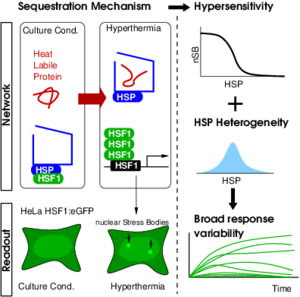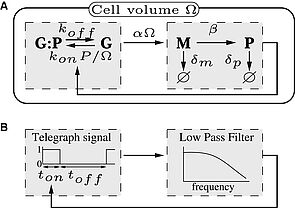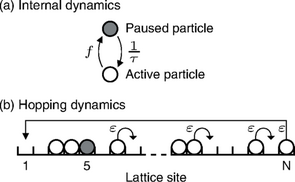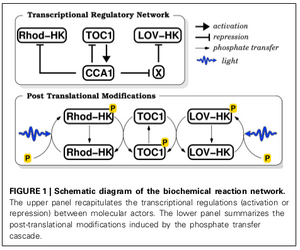
Quentin Thommen
Research areas
Current research areas
Dynamics of heat stress in a single cell

Main contributors: M. Guilbert, E. Courtade; B. Pfeuty; F. Anquez (PhLAM)
We study in particular the role of variability in cell fate during a disturbance of the environment (rise in temperature or chemical attack) by an experimental and modeling approach. The increase in temperature, for example, causes weak interactions within the cell, such as hydrogen bonds, which stabilize the spatial folding of proteins: this is denaturation. Unfolded proteins aggregate, causing loss of biological activity which can lead to cell death. Chaperone proteins, which contain few hydrogen bonds and are therefore thermally stable, prevent denaturation by strengthening the ternary structure of proteins and restore their good conformations.
Even in a population of monoclonal cells (identical genome) there is a continuum of response regarding the activation of the intracellular protection mechanisms and a partial mortality of the population (some cells survive stress, others do not). Experimentally, we follow, by video microscopy, a population of 500 cells over a week with a temporal resolution of the order of one minute. After quantification of the images by segmentation and an automated image analysis, we obtain the follow-up of the activation of the cellular response and of fate (death and type of death). We thus have time series for each cell of the population, making it possible to study variability experimentally. The establishment, from time series, of a regulatory network model guides the study concerning the origin of the variability.
Understanding and controlling cell variability is a major challenge in anti-cancer therapies. In this context, stress is used to eradicate cancer cells, but because of cellular variability, there is always a fraction of resistant cells that re-profile. Consequently, the ability to finely control variability and cell death, guided by a dynamic predictive model, must allow optimization of treatments. Consequently, our work is aimed as much at the biology community and more particularly at system biology for the “single cell” and “origin of response variability” aspects, as at the community of practitioners for the “new” aspect. therapeutic perspectives ”. These works are the subject of five publications
Optofluidic
Main contributors: E. Courtade, J. Pesez, M. Layachi (PhLAM); A. Treizebré (IEMN); K. Braekmans (U. Gent)
This research axis revolves around two experimental activities consisting in acting selectively by light on living human cells circulating at high speed (∼3000 cells per second), in single file, at the center of a microfluidic channel ( ∼μm wide). The cells are analyzed in real time, one by one, using a fluorescence measurement. This analysis conditions the activation or not of an optical effector aimed either at (1) altering cell viability (2) deflecting the trajectory of cells or (3) incorporating an agent or a molecule.
One of the projects, conducted as part of the ERC Nanobubble (carried by K. Braekmans at U. Gent), aims at high-speed photoporation in a microfluidic channel. Nanobubbles are optically generated within the cladding fluids surrounding the cells in the microfluidic channel, the collapse of the nanobubbles and the shock wave which follows, allows the transient opening of nanopores in the cell membrane and therefore l intracellular incorporation of an agent or a molecule of the extracellular medium without modification of the cell viability. One of the application objectives of this project is the improvement of genetic therapies.
Research areas in standby
Transcription and self-repressed gene dynamics


Main collaborators: M. Lefranc and B. Pfeuty (PhLAM)
According to the central dogma of molecular biology, DNA produces an intermediate molecule, messenger RNA (transcription step) serving as a matrix for the production of proteins (translation step) encoding the gene under consideration. Transcription is a complex step during which several enzymes (RNA polymerase) move along the nucleotide sequence of DNA by making pauses, of variable duration, the time to perform a structural rearrangement causing, due to the exclusion, enzyme bottlenecks. In addition, the transcription stage is also regulated upstream by interactions between DNA and proteins, thus allowing functional differentiation of cells and forming genetic regulatory circuits. Regulation of the gene by the protein it produces (we speak of self-regulation) is a motif frequently encountered in nature and has been widely studied.
Using the tools of statistical physics and non-linear dynamics (TASEP, Master equation, Bifurcation analysis) we have shown the interference between exclusion dynamics and pause dynamics leading to bottlenecks of RNA polymerase and to the modification of the transcription rate, as well as the spontaneous oscillation of the self-repressed gene in the presence of a mechanism of nonlinear degradation or of stochastic fluctuation of transcription.
Circadian clock

Main collaborators: M. Lefranc and B. Pfeuty (PhLAM); F.Y. Bouget (LOMIC -UMR 7621 CNRS-UPMC)
The day / night alternation induces periodic variations in the environment (light, temperature) that most living organisms, including humans, anticipate thanks to an internal clock called circadian. These clocks run over a period close to the 24 hours that the light / dark cycle lasts. The cogs of these clocks are genes which interact in order to reciprocally modulate their activity: for example, an “A” gene produces proteins which activate a “B” gene, the “B” gene in turn produces proteins which when they are active, inactivate the "A" gene, and so on. The activity of these genes thus oscillates spontaneously, with a period close to 24 hours. In the cell, we can thus have an indication of the time it is by measuring the concentration of these proteins and therefore their activity.
From experimental measurements conducted by the team of F.Y. Bouget from the Banyuls Oceanological Observatory (CNRS / UPMC) on the clock of the unicellular green alga Ostreococcus tauri. We have studied through a mathematical model, the robust synchronization properties of the clock on the day / night cycle.
Research axes developed during the thesis and postdoctoral research 2001--2006
Quantum dynamics in light potentials
PhD research subject , in collaboration with Jean-Claude Garreau and Véronique Zehnlé (PhLAM).
The techniques of cooling and trapping of atoms by lasers make it possible to obtain atomic gases of very low density at temperatures of the order of a few micro-Kelvin. The use of laser fields makes it possible to apply various mechanical potentials to atoms (we then speak of `` light potentials ''), such as for example an inclined network, the sum of a spatially periodic term and a linear term. :, interesting potential due to its double space - energy translation symmetry. The quantum dynamics of an atom in an inclined network has been known since Zener's work in 1928. It remains nonetheless topical: it is an oscillation on several wells of potential called: the oscillations of Bloch. This purely quantum dynamic translates the existence of a natural frequency in the inclined network.
- Quantum dynamics in an tilted lattice
By an analytical study, we have shown that the harmonic modulation of the parameters of the inclined network induces a resonance phenomenon between the modulation frequency and the natural frequency inducing a coherent transport of the particle in the inclined network: translation and / or diffusion. This transport is piloted by the initial quantum coherences of the atom while the speed of movement is proportional to the amplitude of modulation.
In the case of a two-dimensional network, the slow modification of the modulation amplitudes in the two directions of space makes it possible to temporarily control the speed of the particle and to generate a large variety of trajectories of the atom in the plane, thus achieving a quantum engine. Similarly, the spatial modification of the modulation amplitude makes it possible to concentrate an atomic cloud or to induce a rotation in the plane of the atomic wave function.
- Dynamics of a Bose Einstein condensate in an tilted lattice
Bose Einstein condensation is the macroscopic accumulation of particles in the lower energy state of a potential well. The gas of condensed atoms can then be considered as a single particle. The dynamic evolution of a {Bose Einstein condensate} in the inclined network without temporal modulation is much richer and more varied than the evolution of an atom, due to the non-linearity introduced by the description in mean field of interactions between particles.
We have shown that the quantum dynamics of Bose Einstein's condensate is described by a classical trajectory in this ad hoc phase space and corresponds to that of a quasi-integrable Hamiltonian system, including a chaotic temporal evolution (in the classical sense). . The formal analogy demonstrated between the quantum dynamics of condensate in an inclined network and the dynamics of a chain of coupled classical non-linear oscillators is a new and remarkable result,
- Reconstruction of the wave function {\ it via} the Bloch oscillations
Finally, we established a method, using Bloch oscillations and allowing the complete determination of the atomic wave function. If Heisenberg's principle of indeterminacy prevents us from jointly defining position and speed exactly, there is, in fact, no limit to the knowledge of the wave function. The expression of the wave function in real space plays a major role in our understanding of quantum mechanics, and the implementation of an experimental technique to reconstruct it is of great interest \ footnote {Then that the spatial probability distribution is often easily measurable, the measurement of the phase generally requires the use of an additional method and often incompatible, because the measurement of the position of a quantum system generally erases the information
Left-handed materials induced by quantum coherences
Research subject developed as part of my post-doctorate in collaboration with Paul Mandel of the Université Libre de Brussls (Belgium) --- this subject is no longer active
In 1964, Veselago theoretically studied the propagation of electromagnetic waves in material media with real and negative permittivity and permeability. The reflection index is then real and the medium propagates the electromagnetic waves. The striking fact is that by studying the conditions of passage of the fields, Veselago shows that these materials must be assigned a negative reflection index. Moreover, in these materials, the trihedron formed by the electric field, magnetic excitation and the wave vector vectors is indirect, that is to say that it follows the rule of the left hand. Such environments were then called `` left-handed materials ''.
In 2000, Pendry demonstrated that left-handed materials make it possible to focus electromagnetic waves below the wavelength of radiation by amplifying evanescent waves. Left-handed materials thus open the way to the production of "perfect lenses". Since then, motivated by technological applications, the study and production of left-handed materials have been the subject of considerable research efforts. The interest of left-handed materials is twofold, both theoretical and practical. Experimentally, the first left-handed material was obtained in the microwave field by the use of a network of metallic electromagnetic resonators.
Our approach is to use atomic transitions like electromagnetic resonators in order to modify the electromagnetic constants in a spectral domain close to the transition frequencies: an electric dipole transition plays the role of the electric resonator and a magnetic dipole transition plays the role of the magnetic resonator .
From a general scheme involving four atomic levels, we presented the first theoretical demonstration of the existence of left-handed parameter domains in an atomic gas. The absorption has been reduced by playing on the quantum interference between transition amplitudes. In addition, using the spectroscopic properties of the erbium ion placed in a crystal matrix, we presented a different scheme allowing the first theoretical demonstration of left-handed properties of a crystal due to quantum coherences. It is remarkable that the left-handed domain is centered around the wavelength used for telecommunications transmissions (1.54 µm).



